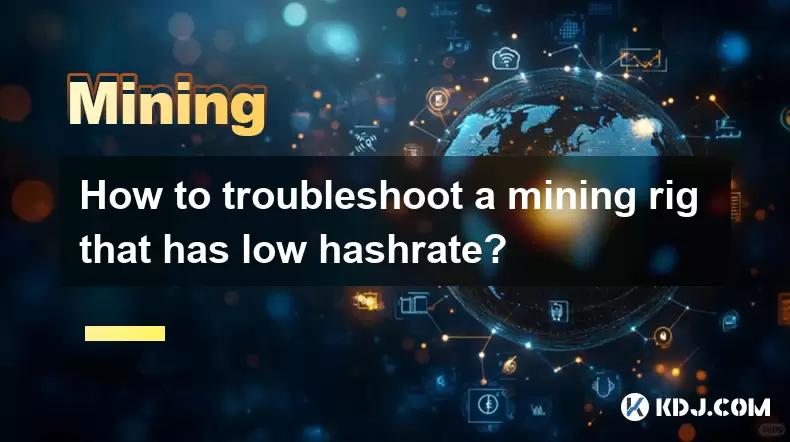-
 bitcoin
bitcoin $121833.232455 USD
-0.63% -
 ethereum
ethereum $4394.437030 USD
-2.00% -
 tether
tether $1.000570 USD
0.04% -
 bnb
bnb $1255.553465 USD
-3.73% -
 xrp
xrp $2.814944 USD
-1.59% -
 solana
solana $221.835346 USD
-2.40% -
 usd-coin
usd-coin $0.999869 USD
0.01% -
 dogecoin
dogecoin $0.249495 USD
-1.32% -
 tron
tron $0.336905 USD
-1.24% -
 cardano
cardano $0.816464 USD
-1.69% -
 chainlink
chainlink $22.130946 USD
-1.27% -
 hyperliquid
hyperliquid $44.208522 USD
-3.46% -
 ethena-usde
ethena-usde $1.000521 USD
0.02% -
 sui
sui $3.422897 USD
-2.51% -
 stellar
stellar $0.380164 USD
-1.31%
How to troubleshoot a mining rig that has low hashrate?
Low hashrate in mining rigs can result from overheating GPUs, outdated drivers, faulty hardware, or improper software settings, all of which reduce mining efficiency and profitability.
Jul 18, 2025 at 03:16 am

Understanding the Causes of Low Hashrate in a Mining Rig
When a mining rig experiences low hashrate, it can significantly reduce profitability and efficiency. Several factors may contribute to this issue, including hardware limitations, software misconfigurations, or environmental conditions. The first step in troubleshooting is identifying the root cause, which could range from outdated drivers to overheating GPUs. Each potential cause must be examined carefully to restore optimal performance.
Overheating is one of the most common reasons for reduced hashrate. When GPU temperatures rise beyond safe thresholds, the mining software throttles performance to prevent damage. Monitoring tools like MSI Afterburner or HWInfo can help track temperature levels in real-time.
Checking Hardware Components for Performance Issues
Before diving into software-related troubleshooting, ensure that all hardware components are functioning correctly. Faulty GPUs, insufficient power supply, or inadequate cooling systems can lead to suboptimal performance.
- Inspect each GPU for physical damage or signs of wear. Bent pins on PCIe slots or damaged fans can impair performance.
- Verify that your power supply unit (PSU) provides enough wattage for all connected components. Undersized PSUs can cause instability and lower hashrates.
- Ensure that all PCIe risers are properly seated and not causing communication issues between the motherboard and the GPUs.
If you're using multiple GPUs, test them individually to identify any underperforming units. Replacing faulty hardware can dramatically improve overall hashrate.
Optimizing Software and Drivers for Maximum Efficiency
Outdated or incompatible software can severely impact mining performance. This includes both the operating system and the specific mining application being used.
- Update your GPU drivers to the latest version compatible with your mining software. For NVIDIA cards, use the DCH drivers; for AMD, consider using Adrenalin Edition.
- Use optimized mining kernels such as those provided by NiceHash, HiveOS, or custom ETHlargementPill versions for Ethereum-based mining.
- Ensure that your BIOS settings allow for full PCIe lane utilization and proper memory timings.
Sometimes, default driver settings are not optimized for mining workloads. Custom BIOS profiles tailored for mining can boost performance significantly.
Adjusting Mining Settings and Configuration Files
Improperly configured mining software can also result in poor hashrate. Most mining applications allow users to tweak parameters through configuration files or command-line arguments.
- Review your mining config file (e.g., .bat or .conf) to ensure it's using the correct algorithm, pool address, and worker name.
- Add or modify flags such as --max-temp, --auto-gpu, or --intensity to adjust how aggressively the miner runs.
- If using NiceHash, check the “Local Speed” tab to see if benchmarking needs to be redone after driver or BIOS changes.
Some miners benefit from manual tuning of memory clocks and core speeds. Tools like Claymore’s Dual Miner or PhoenixMiner allow detailed tweaking via command line parameters.
Monitoring System Stability and Resource Usage
System instability caused by resource overuse or background processes can interfere with mining operations. High CPU usage or RAM exhaustion can bottleneck GPU performance.
- Open Task Manager or htop (on Linux) to monitor CPU, RAM, and disk usage during mining.
- Disable unnecessary startup programs that consume system resources.
- Check for background updates from Windows or antivirus software that might interrupt mining sessions.
Mining rigs should ideally run a minimal OS with only essential services enabled. Using lightweight operating systems like HiveOS or SimpleMining can help maintain stability.
Frequently Asked Questions (FAQs)
Q: Can overclocking improve my mining hashrate?A: Yes, overclocking can enhance hashrate, but it must be done cautiously. Increasing memory clock speed often yields better results than raising core clocks. Always monitor temperatures and stability when applying overclock settings.
Q: Why does one GPU show a much lower hashrate than others?A: A single GPU performing poorly could indicate a hardware defect, incorrect BIOS settings, or driver conflicts. Try swapping its position with another GPU to determine if the issue follows the card or remains tied to the slot.
Q: How do I know if my PSU is underpowered?A: Signs of an undersized PSU include random reboots, GPU instability, or failure to POST. Use a PSU calculator to estimate total system wattage and ensure your PSU exceeds that by at least 10–15%.
Q: Is it normal for hashrate to drop during mining?A: Temporary drops can occur due to thermal throttling or network latency. However, consistent low hashrate indicates a deeper issue with hardware, software, or configuration that requires investigation.
Disclaimer:info@kdj.com
The information provided is not trading advice. kdj.com does not assume any responsibility for any investments made based on the information provided in this article. Cryptocurrencies are highly volatile and it is highly recommended that you invest with caution after thorough research!
If you believe that the content used on this website infringes your copyright, please contact us immediately (info@kdj.com) and we will delete it promptly.
- Avalanche, BLAZ, and Presale Opportunity: Catching the Next Wave in DeFi
- 2025-10-10 18:45:17
- Analyst's Crystal Ball: Will BRETT Mirror PEPE's Moonshot?
- 2025-10-10 18:45:17
- Token Economy, AI Inference, and the New Gold Rush: Decoding the AI Investment Boom
- 2025-10-10 18:50:01
- Dogecoin, Pepe Coin, and Remittix: A New York Minute on Crypto Trends
- 2025-10-10 18:25:14
- Pudgy Penguins Price Prediction: Cup-and-Handle Pattern Hints at Breakout?
- 2025-10-10 18:50:01
- Solana, Ozak AI, and the Crypto Market: Navigating the Hype
- 2025-10-10 18:50:01
Related knowledge

The difference between staking and mining
Sep 24,2025 at 05:18am
Understanding Staking in the Cryptocurrency Ecosystem1. Staking involves holding funds in a cryptocurrency wallet to support the operations of a block...

How to participate in testnet mining?
Sep 22,2025 at 09:18am
Understanding Testnet Mining in the Crypto Ecosystem1. Testnet mining is a method used by blockchain developers to simulate real-world conditions on a...

How to dispose of abandoned mining machines?
Sep 19,2025 at 08:19pm
Assessing the Condition of Abandoned Mining Rigs1. Begin by inspecting each mining machine for visible damage, corrosion, or missing components. Machi...

How to identify high-quality mining pools?
Sep 21,2025 at 03:19pm
Reputation and Track Record1. A mining pool’s reputation is built over time through consistent performance and transparency. Pools that have operated ...

Advantages of decentralized mining pools
Sep 20,2025 at 04:36pm
Enhanced Security and Resistance to Censorship1. Decentralized mining pools operate on blockchain-based smart contracts, eliminating the need for a ce...

What is mining machine overclocking?
Sep 21,2025 at 07:19pm
Understanding Mining Machine Overclocking1. Mining machine overclocking refers to the process of increasing the operating frequency of a cryptocurrenc...

The difference between staking and mining
Sep 24,2025 at 05:18am
Understanding Staking in the Cryptocurrency Ecosystem1. Staking involves holding funds in a cryptocurrency wallet to support the operations of a block...

How to participate in testnet mining?
Sep 22,2025 at 09:18am
Understanding Testnet Mining in the Crypto Ecosystem1. Testnet mining is a method used by blockchain developers to simulate real-world conditions on a...

How to dispose of abandoned mining machines?
Sep 19,2025 at 08:19pm
Assessing the Condition of Abandoned Mining Rigs1. Begin by inspecting each mining machine for visible damage, corrosion, or missing components. Machi...

How to identify high-quality mining pools?
Sep 21,2025 at 03:19pm
Reputation and Track Record1. A mining pool’s reputation is built over time through consistent performance and transparency. Pools that have operated ...

Advantages of decentralized mining pools
Sep 20,2025 at 04:36pm
Enhanced Security and Resistance to Censorship1. Decentralized mining pools operate on blockchain-based smart contracts, eliminating the need for a ce...

What is mining machine overclocking?
Sep 21,2025 at 07:19pm
Understanding Mining Machine Overclocking1. Mining machine overclocking refers to the process of increasing the operating frequency of a cryptocurrenc...
See all articles

























![Web3 Crypto Market Morning Report: Fomo on the Bnb chain continues, Binance launches the chain-sweeping platform Meme Rush, the market value of Xiuxian exceeds 40 million U.S. dollars, OK Binance business war begins [Vic TALK Issue 1437] Web3 Crypto Market Morning Report: Fomo on the Bnb chain continues, Binance launches the chain-sweeping platform Meme Rush, the market value of Xiuxian exceeds 40 million U.S. dollars, OK Binance business war begins [Vic TALK Issue 1437]](/uploads/2025/10/10/cryptocurrencies-news/videos/web-crypto-market-morning-report-fomo-bnb-chain-continues-binance-launches-chainsweeping-platform-meme-rush-market-xiuxian-exceeds-dollars-binance-business-war-vic-talk-issue/68e861c5dbd1c_image_500_375.webp)
















































